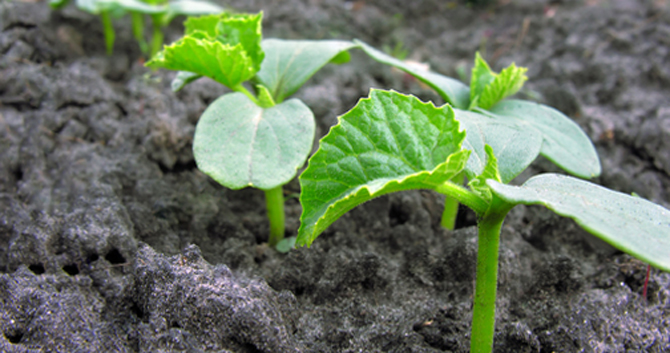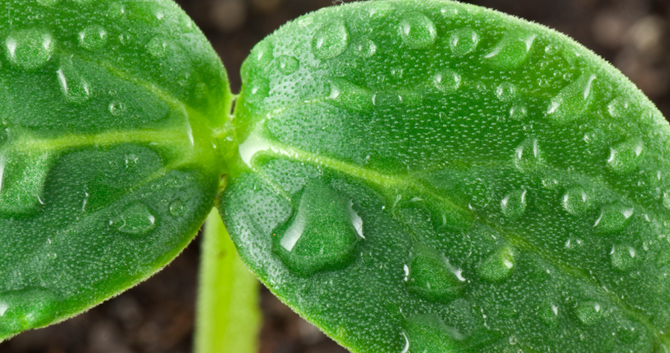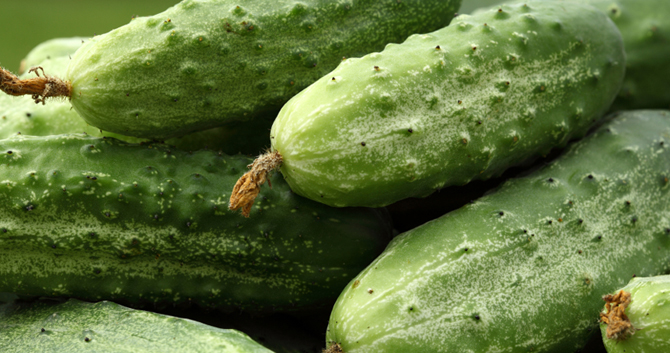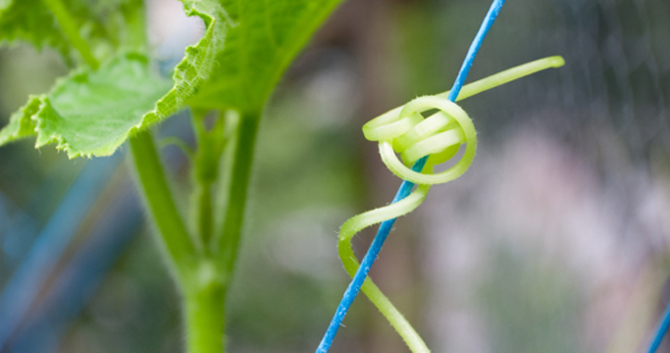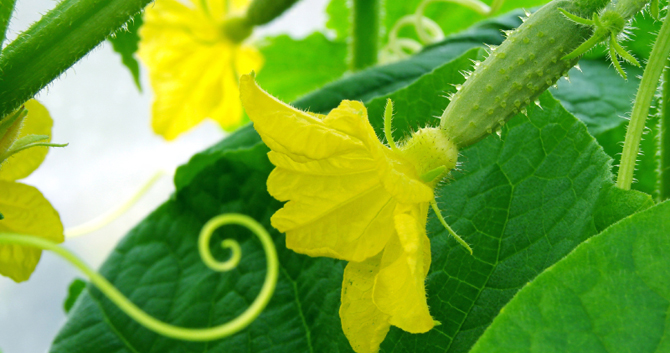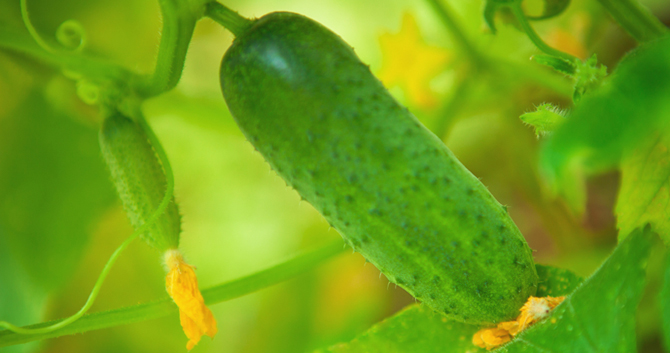Warm summer days and nights mean cucumbers, and lots of them! Add them to a salad for a nice crunch, enjoy as a simple snack, or pickle for a year-round treat!
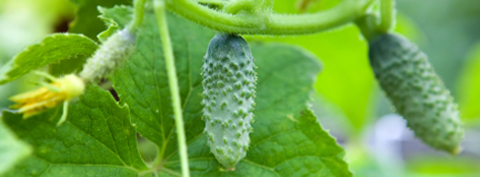 As a rule of thumb, the more cucumbers you harvest, the more you'll get!
As a rule of thumb, the more cucumbers you harvest, the more you'll get!
If you've grown cucumbers, you know "onwards and upwards" is their motto. If you haven't, you'll be pleasantly surprised at how easy they are to grow. This climbing plant with curly tendrils will latch onto anything nearby in your garden for support. Their stems reach to the sky and grow larges leaves, creating a bright green canopy that shades the fruit from the hot sun.
Sweet and crisp, cucumbers are approximately 95 percent water. We’ve all heard the expression "cool as a cucumber" referring someone calm under pressure, but factually speaking cucumbers have earned their reputation. The inside of a cucumber can be 20 degrees cooler then the outside air - no wonder they are so refreshing!
Cucumbers are members of the gourd family, Curcubitaceace, which also includes melons and squash. Originally from India, it’s no wonder they like the hot weather.
With a little preparation and attention, you’ll soon have a garden filled with cucumbers. The following tips will help get you started!
Types of Cucumbers:
When growing cucumbers, you’ll have lots of varieties to choose from, but there are two basic types - slicing and pickling. Slicing cucumbers are large varieties with smooth, thin skins and few seeds. They can be eaten right from the garden without peeling or seeding. Pickling cucumbers are perfectly sized to fit into a canning jar without slicing. Usually no more than 3 to 5 inches long, they have firm, bumpy skin that stays crisp during the brining process.
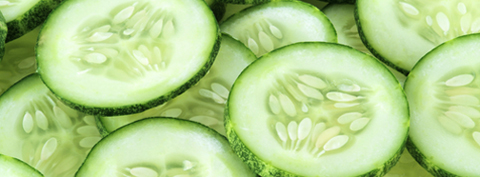 In general, there are two types of cucumbers - slicing and pickling.
In general, there are two types of cucumbers - slicing and pickling.
Why not try growing several varieties and give yourself a summer vacation from the hum-drum supermarket selection?
Some of the best slicing cucumbers include Armenian, English, Market, Japanese, and lemon types. Some of these can grow to the size of a baseball bat, but are generally harvested much sooner, when they reach a manageable size for salads. They can also be harvested when very small and used for snacking or pickling.
Armenian cucumbers are considered the Cadillac of slicers. They are hard to find in the supermarket, so growing them in your own garden will provide an exclusive and reliable supply. Crisp and mild with a sweet mellow citrus flavor, tender skin and soft seeds, they don’t need to peeled or seeded! They can grow up to three feet long, but why wait when you can begin enjoying them much sooner?
English cucumbers are sweet and mild with a tender skin and few seeds. Because their seeds are small and soft, the middle of the cucumber has the same firm crunch as the edges. They can grow up to two feet long but are best when harvested 2/3 to 1/2 that size, immature and dark green.
Garden or Market cucumbers are true American classics - crisp, sweet, and flavorful. Their skin is a bit thicker than other slicing types, which means that they keep well. These are often the same varieties sold at the supermarket, but without the added waxy coating grocers apply to protect and extend shelf-life. Varieties like Straight Eight, named an All-American Selection in 1935, Slicemaster, and Burpless Garden Sweet are reliable and prolific – they’ll reward you with an abundance of cucumber to share with the neighborhood.
Japanese cucumbers are similar to English cucumbers, only with bumps. Like English cucumbers, they don't have to be peeled or seeded.
Lemon cucumbers are small, round and yellow, just like their namesake. They’re much sweeter than other varieties with far less bitterness. Unlike other slicing varieties, lemon cucumbers are also good for pickling.
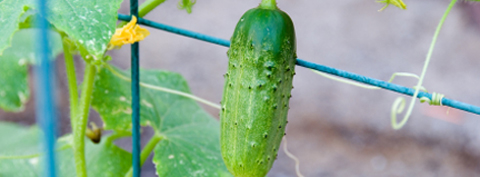 Be sure to pick your cucumbers before they turn yellow or get too large.
Be sure to pick your cucumbers before they turn yellow or get too large.
Pickling cucumbers are extremely versatile. You can make sweet, sour, or dill pickles, French cornichons, or bread and butter pickles—just find a recipe and go! They’re also delicious eaten fresh from the garden and often don’t make it into the pickle jar. The most popular pickling type is the Kirby cucumber. Short and bumpy, it ranges in color from yellow to dark green. Crisp and flavorful with inconspicuous seeds, they’re best harvested when less than 4 inches.
Getting Started:
When planning your garden, be sure to select a sunny spot where your cucumbers will receive at least 6 hours of sun each day. Give them plenty of room, unless you plan on using trellises to help plants grow vertically or will be growing dwarf or bush varieties that take up much less space. These are both great options for gardeners with small spaces, container gardens, or for gardeners with large plots who want to devote a little less room to growing cucumbers.
In general, cucumbers are not fussy and will grow in most soils as long as there is good drainage. Before planting, remove debris and loosen the soil, breaking up any clumps that are larger than an apple. Add compost or other organic garden mix to encourage root growth for a healthy plant.
Care Tips:
With the proper care you’ll be on your way to an abundant harvest. The following hints and tips will help lead you in the right direction!
Planting: After danger of frost has past, plant your cucumbers in low mounds or ‘hills’ of 2-3 plants, spaced about 4 feet apart—3 feet for bush types. This ensures good drainage and warm soil for small transplants. If you are growing your cucumber plants on trellises, space plants one foot apart in their row.
Watering: Cucumber vines have shallow roots and need consistent moisture.Water deeply as needed to keep soil moist, rather than apply frequent, shorter sprinklings. Water in the morning at the base of the vine to keep leaves dry and disease free. Keep up with consistent watering when your cucumbers start to mature or the fruit will become bitter.
Mulching: To help ensure happy, healthy plants, apply a 2 to 3 inch layer of composted mulch after planting. This helps the soil retain moisture and keep weeds to a minimum.
Fertilizing: Choose a product formulated for fruiting vegetables and follow package directions. Consider using an organic fertilizer to help increase the productivity of your soil and boost your cucumber’s immune system, making plants more resistant to pests and disease.
 Cucumber tendrils will latch onto almost anything nearby for support!
Cucumber tendrils will latch onto almost anything nearby for support!
Pruning: If you are growing your cucumbers on a trellis, you may increase yields by pruning the vines. Although somewhat counterintuitive, in this situation cucumbers perform better if they are kept to one main stem without any side shoots. Pinching off the smaller stems focuses the plant’s energy on fruit production rather than growing more foliage. Also pick off any flowers that form before the vine has at least seven leaves.
Staking: Cucumbers instinctively grow upwards and are easily trained to climb trellises to save space in large and small gardens alike. Begin staking the vines when they reach six inches long and tie them at one foot intervals as the stems continues to grow.
Harvesting:
As a rule of thumb, the more cucumbers you harvest, the more you’ll get! Not only are larger fruits more likely to be bitter, keeping them on the vine slows down fruit production—so pick them while their still young and tender. Once cucumbers get started, they mature quickly. Harvest pickling cucumbers daily so they don’t grow beyond 2-4 inches long. Harvest slicing cucumbers when they reach 6-8 inches.
If you happen to miss one hiding among the leaves, remove it immediately to encourage young fruits to develop and new flowers to form.
In late summer, start pinching off any new blossoms so any remaining cucumbers have time to mature before the first winter frost.
Companion Plants:
Certain plants will help your cucumbers thrive and produce more fruit. Anything that attracts pollinators or deters pests will improve your chances of success.
Flowers such as cosmos, coneflowers, bee balm, lavender, sunflowers, and zinnias are magnets for bees and will bring them into the garden to help you succeed.
Pungent plants like garlic, nasturtiums, marigolds, and radishes deter unwanted pests like aphids and cucumber beetles.
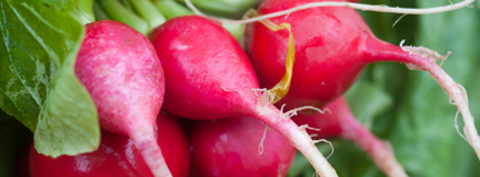 Radishes help deter unwanted pests from you cucumbers.
Radishes help deter unwanted pests from you cucumbers.
If you’ve trained your cucumbers grow vertically, there’s room to take advantage of the space between plants to grow shorter vegetables like cabbage, cauliflower, broccoli, eggplant, lettuce, peas, or peppers.
Conversely some plants are not good neighbors when grown near cucumbers. Potatoes, sage or aromatic herbs can inhibit the growth of your cucumbers if planted nearby.
Trouble Shooting:
Despite our best efforts, some gardening problems occasionally arise, often due to weather or pests. Some are easily remedied, like problems with fruit production and bitter taste. For more serious problems, consult your garden center for help and advice.
Yellowed cucumbers are overripe and no longer palatable. Remove them from the vine to direct the plant’s energy into new fruit production.
Stalled production: There two main reasons your vines have stopped producing – you may be behind on harvesting or the bees may not be visiting to pollinate the blossoms. If you have large fruit dangling from your vines, pick them immediately so the plant’s energy will go into growing more fruit. Cold temperatures or rainy weather can keep the bees away, and if this is the case they should return once the sun shines and the temperatures warm.
 Pickling cucumbers are sized just right to fit into the jar but you can also use baby cucumbers!
Pickling cucumbers are sized just right to fit into the jar but you can also use baby cucumbers!
Misshapen Cucumbers: This usually caused by poor pollination. Remove any deformed cucumbers to encourage new ones to form. It can also be caused by low soil fertility, so if you haven’t fertilized your plants, give them a shot of water-soluble fertilizer. Follow up with a top-dressing of a granular product formulated for vegetables, and follow package instructions.
Bitter Taste: Cucumbers develop a bitter taste with uneven watering or when the temperature swings more than twenty degrees. Keep plants consistently watered, especially once fruit starts maturing.


